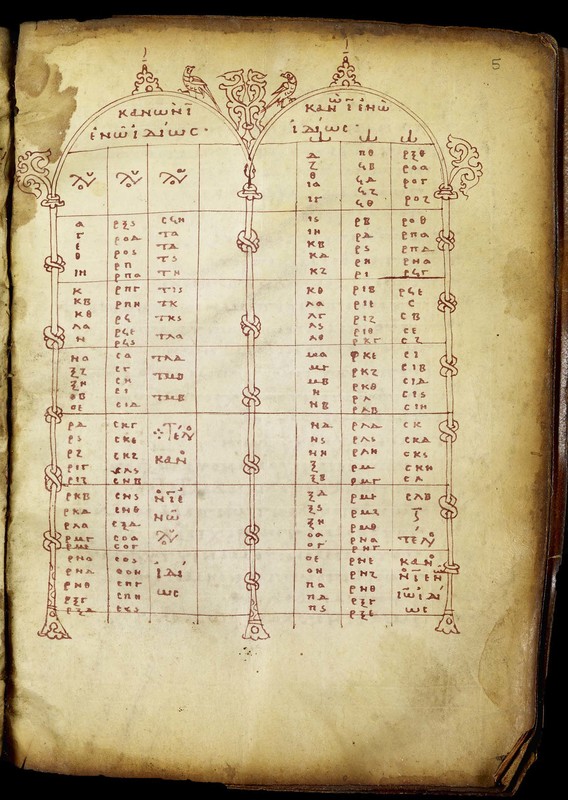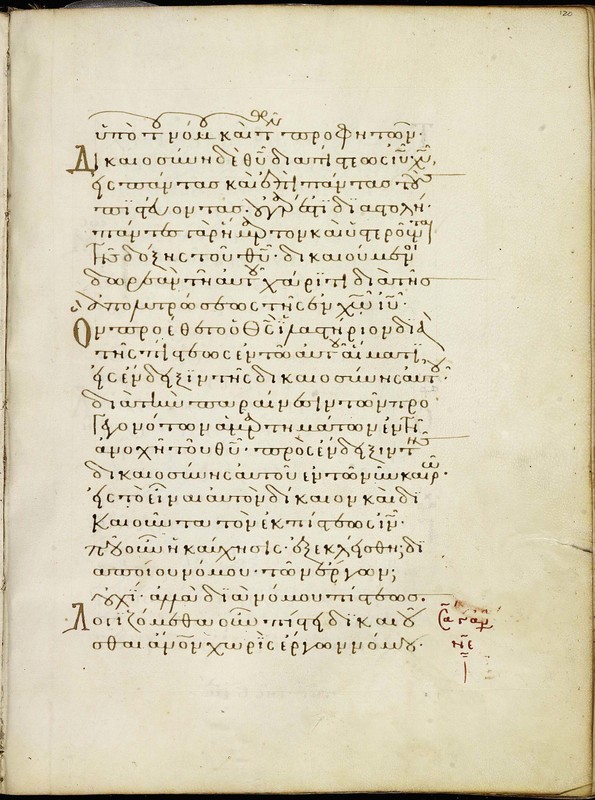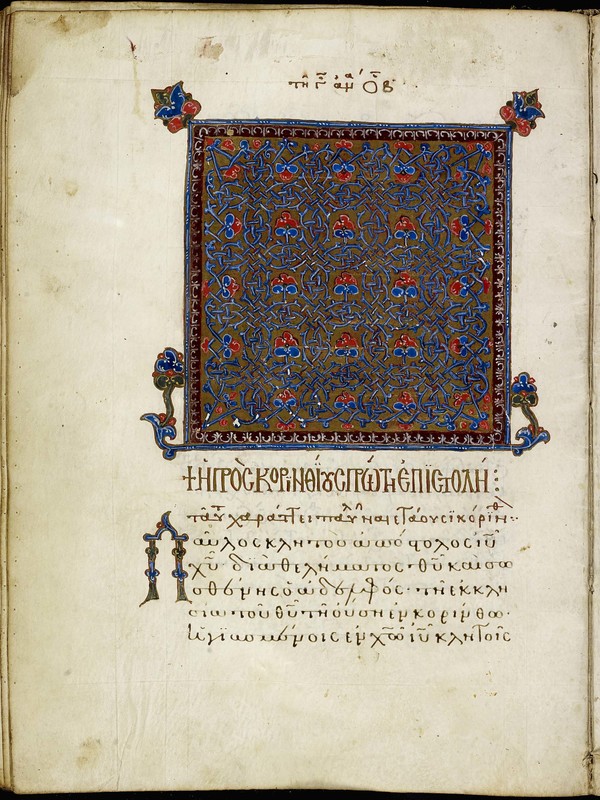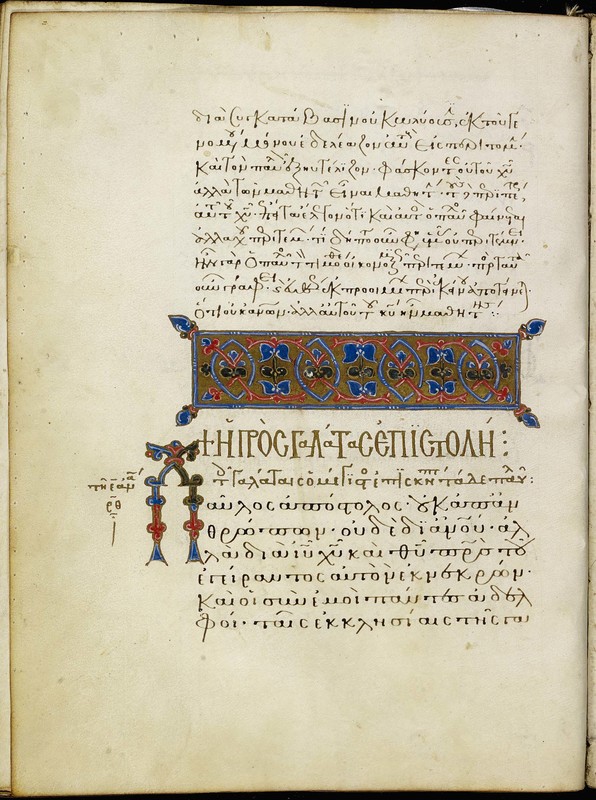The Byzantine Bible
Constantine the Great declared Christianity as the official religion of the Roman Empire in 324 CE. In the following year, theologians gathered at the Council of Nicea to establish the unifying theological principles of Christianity. When Constantine made Byzantium (modern Istanbul) the second capital of the Roman Empire in 330, he would mark the beginning of the eastern, or Byzantine, Empire, initiating a gradual split between the Roman and the Orthodox Churches. This schism was exacerbated in the eleventh century and it persists today, with he Pope in Rome as head of the Catholic Church and the Patriarch of Constantinople as head of the Eastern Orthodox Church.
Whereas Latin was the language of administration and Law in the western half of the Empire, Greek was widely spoken in the eastern provinces, particularly among the upper classes of large cities like Constantinople. In 332, Constantine began the tradition of what we can broadly describe as the "Byzantine Bible" by commissioning the making of fifty codices of the Scriptures for the new churches that he was planning to build in Constantinople. The Emperor specified that these manuscripts should be made of well-prepared parchment, and copied with a legible script that was both accurate and artistic.
The page displayed above is part of a manuscript (Mich. Ms. 22) containing the text of the Four Gospels and including full-page portraits of the evangelists Matthew, Mark, and Luke (the one of John is missing). The script is small, rounded, uniform, and with a slight inclination to the right. The style of the handwriting suggests that our manuscript can be dated to the end of the tenth or beginning of the eleventh century.
A common feature of the Byzantine manuscript of the Four Gospels is the presence of the Canon Tables, which provide a list of those passages that are paralleled in two or more Gospels. Originally gathered by Eusebius of Caesarea in the fourth century CE, these tables or lists were designed to emphasize the agreements between different accounts of the events of the life of Christ. The Canon Tables of our manuscript were drawn with magenta ink and decorated with knots and finials and initials in the shape of palmettes. In the image above, we can see two birds perched on the arched tops of the tenth canon table.
The three extant miniatures with portraits of the evangelists share some common elements in their composition. The evangelists are portrayed seated on backless chairs covered with cushions that have golden tassels. The feet of the evangelists rest on footstools with red cushions. Each of the evangelists sit in front of a desk with bottles of red and black ink, inkpots, and knives. As the image above shows, Mark is depicted dipping his pen into the inkpot. The desks have high stands holding scrolls from which the evangelists are copying the text of the Gospel on a codex, an extraordinary image that highlights the role played by Christians in the adoption of this book form. These full-page miniatures have a golden background and colorful buildings behind the desks and the evangelists.
Above is an image from a manuscript containing the Acts and Epistles (Mich. Ms. 34). It was copied and decorated in the last quarter of the thirteenth century in Constantinople within the small circle of calligraphers and illuminators of the so-called Palaiologina group, who produced manuscripts for the members of the Byzantine elite. Robert Nelson identified the scribe and the artist as two anonymous craftsmen who also executed cod, Vitr. 34/4 (the Four Gospels), held at the Benaki Museum in Athens. Nelson proposes that the Michigan and Benaki codices were produced as a set of the New Testament lacking the Apocalypse. Inmaculada Pérez Martín identified the anonymous scribe as the monk David and suggested that he was a monk in the Hodegon Monastery in Constantinople. Both the Michigan and the Benaki manuscripts have the ownership inscription of Antonios Malakes, an archbishop of Veroia, a city in central Macedonia.
Like other manuscripts produced by the Palaiologina group, Mich. Ms. 34 is finely decorated with ornamental headpieces, headbands, and initials. There are three major headpieces occupying half the page: at the beginning of the Acts, at the beginning of the Epistle of Paul to the Romans, and at the beginning of the First Epistle of Paul to the Corinthians. The palette in all the headpieces is red, bright royal-blue, and dark blue with white highlights. This third headpiece on display above shows an abstract interlace interspersed with palmettes. In the three headpieces, there are large floral finials at the top corners, and large palmettes on tall, wavy stems rise from the horizontal bar at the bottom corners. As seen in the next two pages, major initials are elegantly decorated with small rings and stylized flowers.
On display above is one of the eighteen headbands that throughout the manuscript announce the beginnings of the Preface to the Acts of the Apostles, of each of the Epistles, and of the list of readings from the Acts and Epistles for the Menologion (scriptural lessons arranged monthly). This and the other headbands are ornamented with a stylized vegetal and floral design on a gold background, and the palette is red, bright
and dark blue, and white highlights.

The Bible in Coptic
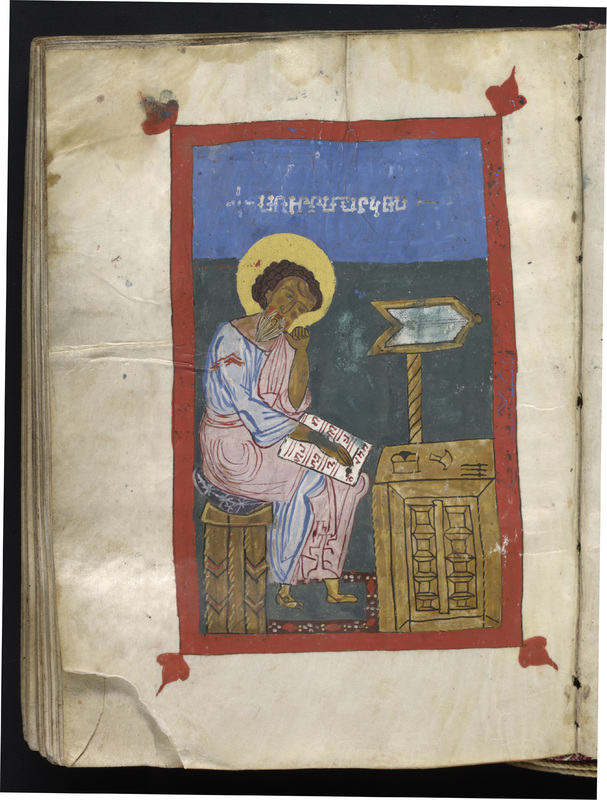
The Bible in Armenian


